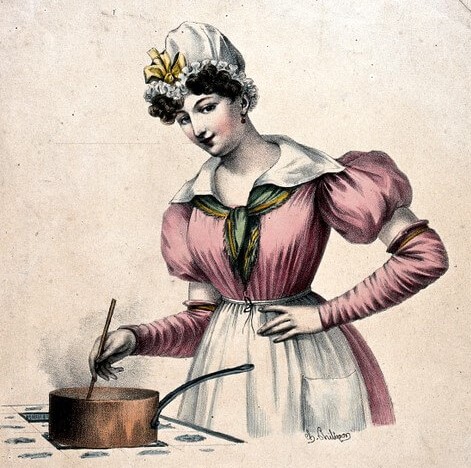Who knew a simple condiment would be in such high demand? Spot shortages, both in grocery stores and online, have highlighted America’s love for this thick, tomatoey sauce. According to statistics, over 305 million Americans used catsup / ketchup in 2019.
One word in the above paragraph, however, doesn’t enter the history of ketchup until the 19th century, and that’s “tomatoey.” The earliest written reference to something resembling tomato catsup is in a handwritten manuscript belonging to Mrs. Samuel Whitehorne of Newport, Rhode Island, called The Sugar House Book, circa 1801-1845, and now part of the collection of the Newport Historical Society. The recipe is commonly attributed to an individual named Sandy Addison, about whom nothing is known. There are also recipes for tomato ketchups that may date to the early 1800s in two unpublished manuscripts from New York.
So if not tomatoes, then what? It helps to keep in mind that the earliest “ketchup” is more accurately described as a spicy, savory, thin, sauce. The most popular types of ketchups prior to the 19th century were mushroom, fish/seafood, and walnut.
Herewith, we offer some receipts for condiments labeled as ketchup from 18th century cookbooks. Enjoy!
To make WALNUT CATCHUP.
Take green walnuts before the shell is formed, and grind them in a crab mill, or pound them in a marble mortar, squeeze out the juice through a coarse cloth, put to every gallon juice one pound of anchovies, one pound of bay salt, four ounces of Jamaica pepper, two of long, and two of black pepper, of mace, cloves, and ginger, each one ounce, and a stick of horseradish; boil all together till reduced to half the quantity, put it in a pot, and when cold bottle it; it will be ready in three months.
To make MUM CATCHUP
To a quart of old mum put four ounces of anchovies, of mace and nutmegs sliced one ounce, of cloves and black pepper half an ounce, boil it till it is reduced one third; when cold bottle it for use.
From: The Experienced English Housekeeper: For the Use and Ease of Ladies, Housekeepers, Cooks, Etc., Elizabeth Raffald, 1786
Note: Mum was an uhopped ale, originally created in Germany and imported into England in the 16th century.
Mushroom Ketchup
Take a bushel of the large flaps of mushrooms gathered dry, and bruise them with your hands; put some at the bottom of an earthen pan, strew some salt over them, then mushrooms, then salt, till you have done; put in half an ounce of beaten cloves and mace, the same of all-spice, and let them stand five or six days; stir them up every day; then tie a paper over them, and bake them for four hours in a slow oven; when so done, strain them through a cloth to get all the liquor out, and let the liquor stand to settle; then pour it clear from the settlings; to every gallon of liquor, add a quart of red wine, and if not salt enough, a little salt, a race of ginger cut small, half an ounce of cloves and mace, and boil it till about one-third is reduced; then strain it through a sieve into a pan; the next day pour it from the settlings, and bottle it for use; but mind to cork it tight.
From: The English Art of Cookery, according to the Present Practice; being a Complete Guide to all Housekeepers, on a Plan Entirely New…..by Richard Briggs, 1788
To make Catchup to keep twenty years
Take a gallon of strong stale beer, one pound of anchovies washed from the pickle, a pound of shallots peeled, half an ounce of mace, half an ounce of cloves, a quarter of an ounce of whole pepper, three or four large races of ginger, two quarts of the large mushroom-flaps rubbed to pieces. Cover all this close, and let it simmer till it is half wasted, then strain it through a flannel bag, let it stand till it is quite cold, then bottle it. You may carry it to the Indies.
Note: This recipe is in a chapter titled: For Captains of Ships
From: THE ART OF COOKERY MADE PLAIN and EASY, by Hannah Glasse, 1770

